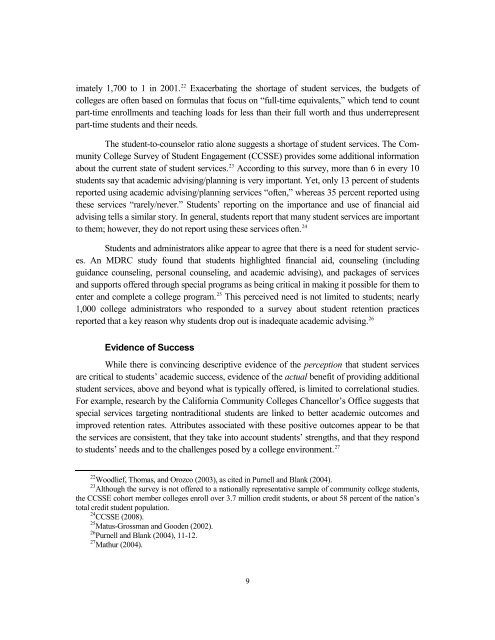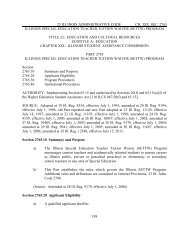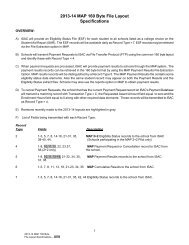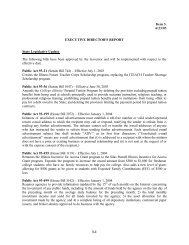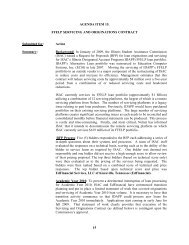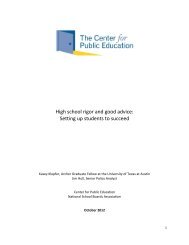nontraditional students will succeed in school. Whether the services are orientation services forstudents who have been out of school for a while, financial aid advising for financially independentstudents, time management training for students who are working full time while attendingschool, or child-care subsidies for parents, the special needs of nontraditional students may beaddressed by enhanced student services.Finally, community college students frequently come from low-income backgroundsand have parents who did not attend college. More than one-fourth of students who attendedcommunity college during the 2003-2004 school year were from families whose income was ator below 125 percent of the 2002 federal poverty threshold. 19 For these low-income students,enhanced services geared toward financial assistance may be critical to their likelihood topersist. Meanwhile, nearly half of all beginning postsecondary students at public two-yearinstitutions had parents whose highest education level was a high school diploma or less in1995-1996. 20 For these students, whose parents are unable to provide experienced guidanceabout life in college, orientation sessions and information on navigating life on campus may beparticularly valuable.Community college students come from a diverse set of backgrounds. Although there isno such thing as a “typical” community college student, the types of students represented oncommunity college campuses often must overcome significant challenges and obstacles in orderto complete their studies. Enhanced student services are designed, in part, to address some ofthose challenges.Quantifying the Shortage of ServicesIn order to understand the enhancement of student services, it is important to considerthe current state of student services. Enhancements could be conceived of as “more” services,“better” services, or both. Described here is some information on the current state of studentservices provided at community colleges — an amount that many perceive as a shortage,suggesting that one starting point for an intervention is simply to provide more services.Academic advising and counseling is arguably the most important student service andan area where most community college students receive minimal help. Extraordinarily highstudent-to-counselor ratios are the most dramatic sign of the shortage of student services. Onestudy shows that the average student-to-counselor ratio in U.S. community colleges is almost1,000 to 1, 21 while a report examining the diversity of the California community college systemfound that the median ratio of students to counselor ranged from 1,400 to 1 in 1994 to approx-19 Provasnik and Planty (2008).20 Horn, Berger, and Carroll (2005).21 Grubb (2001), 6.8
imately 1,700 to 1 in 2001. 22 Exacerbating the shortage of student services, the budgets ofcolleges are often based on formulas that focus on “full-time equivalents,” which tend to countpart-time enrollments and teaching loads for less than their full worth and thus underrepresentpart-time students and their needs.The student-to-counselor ratio alone suggests a shortage of student services. The CommunityCollege Survey of Student Engagement (CCSSE) provides some additional information23about the current state of student services. According to this survey, more than 6 in every 10students say that academic advising/planning is very important. Yet, only 13 percent of studentsreported using academic advising/planning services “often,” whereas 35 percent reported usingthese services “rarely/never.” Students’ reporting on the importance and use of financial aidadvising tells a similar story. In general, students report that many student services are importantto them; however, they do not report using these services often. 24Students and administrators alike appear to agree that there is a need for student services.An MDRC study found that students highlighted financial aid, counseling (includingguidance counseling, personal counseling, and academic advising), and packages of servicesand supports offered through special programs as being critical in making it possible for them toenter and complete a college program. 25 This perceived need is not limited to students; nearly1,000 college administrators who responded to a survey about student retention practicesreported that a key reason why students drop out is inadequate academic advising. 26Evidence of SuccessWhile there is convincing descriptive evidence of the perception that student servicesare critical to students’ academic success, evidence of the actual benefit of providing additionalstudent services, above and beyond what is typically offered, is limited to correlational studies.For example, research by the California Community Colleges Chancellor’s Office suggests thatspecial services targeting nontraditional students are linked to better academic outcomes andimproved retention rates. Attributes associated with these positive outcomes appear to be thatthe services are consistent, that they take into account students’ strengths, and that they respondto students’ needs and to the challenges posed by a college environment. 2722 Woodlief, Thomas, and Orozco (2003), as cited in Purnell and Blank (2004).23 Although the survey is not offered to a nationally representative sample of community college students,the CCSSE cohort member colleges enroll over 3.7 million credit students, or about 58 percent of the nation’stotal credit student population.24 CCSSE (2008).25 Matus-Grossman and Gooden (2002).26 Purnell and Blank (2004), 11-12.27 Mathur (2004).9
- Page 1: OPENING DOORSMORE GUIDANCE,BETTER R
- Page 4 and 5: Funders of the Opening Doors Projec
- Page 7 and 8: ContentsOverviewList of Tables, Fig
- Page 9 and 10: List of Tables, Figures, and BoxesT
- Page 11: PrefaceIf approved by Congress, the
- Page 14 and 15: guidance on the study. Thomas Brock
- Page 16 and 17: • The Ohio colleges successfully
- Page 18 and 19: Program group members were assigned
- Page 20 and 21: • For the most part, the program
- Page 22 and 23: offered, but might also provide stu
- Page 25 and 26: Chapter 1IntroductionOver the last
- Page 27 and 28: The Opening Doors DemonstrationTabl
- Page 29 and 30: sure that students complete the req
- Page 31: While the mechanism through which s
- Page 35: of literature exist on career couns
- Page 38 and 39: The CollegeLorain County Community
- Page 40 and 41: • Were beginning freshmen or cont
- Page 42 and 43: The Opening Doors DemonstrationTabl
- Page 44 and 45: Table 2.1 (continued)SOURCE: MDRC c
- Page 46 and 47: Lorain and Owens Financial Aid Data
- Page 49 and 50: Chapter 3The Implementation of the
- Page 51 and 52: Toward the end of each student’s
- Page 53 and 54: meet with their counselor a minimum
- Page 55: The Opening Doors DemonstrationTabl
- Page 59 and 60: Appendix Table C.2 shows informatio
- Page 61: Opening Doors counselors, and progr
- Page 64 and 65: Program Control Difference Standard
- Page 67 and 68: Chapter 4The Effects of Enhanced St
- Page 69 and 70: Program SemestersTable 4.1 (page 47
- Page 71 and 72: Program Control Difference Standard
- Page 73 and 74: Program Control Difference Standard
- Page 75 and 76: The Opening Doors DemonstrationTabl
- Page 77 and 78: Transcript Outcomes by GenderAssess
- Page 79 and 80: Program Control Difference Standard
- Page 81 and 82: Program Control Difference Standard
- Page 83 and 84:
correspond with the program’s imp
- Page 85 and 86:
Chapter 5Summary and ConclusionsLor
- Page 87 and 88:
The Opening Doors DemonstrationFigu
- Page 89 and 90:
An alternative interpretation of th
- Page 91:
Appendix ASupplementary Baseline In
- Page 94 and 95:
Full Program ControlCharacteristic
- Page 96 and 97:
Appendix Table A.1 (continued)Full
- Page 98 and 99:
Full Program ControlCharacteristic
- Page 100 and 101:
Appendix Table A.2 (continued)Full
- Page 102 and 103:
Appendix Table A.3 (continued)Full
- Page 105:
Appendix BSurvey Response Analysis
- Page 108 and 109:
Background Characteristics of Surve
- Page 110 and 111:
Table B.1 (continued)Characteristic
- Page 112 and 113:
The Opening Doors DemonstrationAppe
- Page 114 and 115:
Table B.2 (continued)SOURCE: MDRC c
- Page 116 and 117:
Table B.3 (continued)Characteristic
- Page 118 and 119:
The Opening Doors DemonstrationAppe
- Page 120 and 121:
Table B.4 (continued)SOURCE: MDRC c
- Page 122 and 123:
Table B.5 (continued)Characteristic
- Page 124 and 125:
The Opening Doors DemonstrationAppe
- Page 126 and 127:
Table B.6 (continued)SOURCE: MDRC c
- Page 129 and 130:
Lorain OwensProgram ProgramOutcome
- Page 131 and 132:
Lorain County Community CollegeOwen
- Page 133:
Appendix DDescription of Scales Pre
- Page 136 and 137:
4. I hardly ever expect things to g
- Page 138 and 139:
Social Support and Civic Engagement
- Page 140 and 141:
Psychological Distress (6-item summ
- Page 143 and 144:
Lorain County Community CollegeOwen
- Page 145 and 146:
Lorain County Community CollegeOwen
- Page 147 and 148:
Lorain County Community CollegeOwen
- Page 149 and 150:
Male SubgroupFemale SubgroupDiffere
- Page 151 and 152:
Male SubgroupFemale SubgroupDiffere
- Page 153 and 154:
Male SubgroupFemale SubgroupDiffere
- Page 155 and 156:
Lorain County Community CollegeOwen
- Page 157 and 158:
Appendix Table E.7 (continued)SOURC
- Page 159 and 160:
Lorain County Community CollegeOwen
- Page 161 and 162:
The Opening Doors DemonstrationAppe
- Page 163 and 164:
Appendix Table E.10 (continued)SOUR
- Page 165 and 166:
ReferencesAdelman, Clifford. 2004.
- Page 167 and 168:
EARLIER MDRC PUBLICATIONS ON OPENIN
- Page 169:
About MDRCMDRC is a nonprofit, nonp


